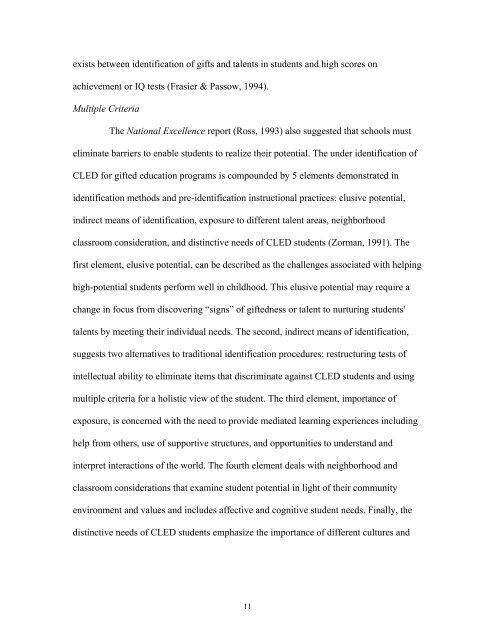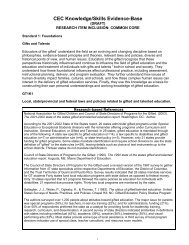Chapter One An Introduction to the Topic of Cultural Diversity - NAGC
Chapter One An Introduction to the Topic of Cultural Diversity - NAGC
Chapter One An Introduction to the Topic of Cultural Diversity - NAGC
Create successful ePaper yourself
Turn your PDF publications into a flip-book with our unique Google optimized e-Paper software.
exists between identification <strong>of</strong> gifts and talents in students and high scores on<br />
achievement or IQ tests (Frasier & Passow, 1994).<br />
Multiple Criteria<br />
The National Excellence report (Ross, 1993) also suggested that schools must<br />
eliminate barriers <strong>to</strong> enable students <strong>to</strong> realize <strong>the</strong>ir potential. The under identification <strong>of</strong><br />
CLED for gifted education programs is compounded by 5 elements demonstrated in<br />
identification methods and pre-identification instructional practices: elusive potential,<br />
indirect means <strong>of</strong> identification, exposure <strong>to</strong> different talent areas, neighborhood<br />
classroom consideration, and distinctive needs <strong>of</strong> CLED students (Zorman, 1991). The<br />
first element, elusive potential, can be described as <strong>the</strong> challenges associated with helping<br />
high-potential students perform well in childhood. This elusive potential may require a<br />
change in focus from discovering “signs” <strong>of</strong> giftedness or talent <strong>to</strong> nurturing students'<br />
talents by meeting <strong>the</strong>ir individual needs. The second, indirect means <strong>of</strong> identification,<br />
suggests two alternatives <strong>to</strong> traditional identification procedures: restructuring tests <strong>of</strong><br />
intellectual ability <strong>to</strong> eliminate items that discriminate against CLED students and using<br />
multiple criteria for a holistic view <strong>of</strong> <strong>the</strong> student. The third element, importance <strong>of</strong><br />
exposure, is concerned with <strong>the</strong> need <strong>to</strong> provide mediated learning experiences including<br />
help from o<strong>the</strong>rs, use <strong>of</strong> supportive structures, and opportunities <strong>to</strong> understand and<br />
interpret interactions <strong>of</strong> <strong>the</strong> world. The fourth element deals with neighborhood and<br />
classroom considerations that examine student potential in light <strong>of</strong> <strong>the</strong>ir community<br />
environment and values and includes affective and cognitive student needs. Finally, <strong>the</strong><br />
distinctive needs <strong>of</strong> CLED students emphasize <strong>the</strong> importance <strong>of</strong> different cultures and<br />
11

















